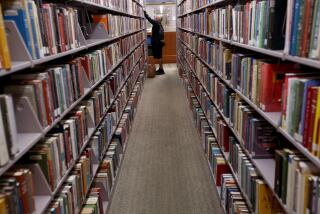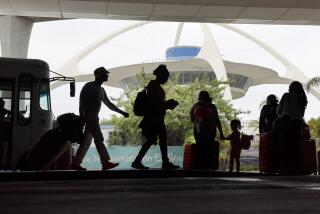Public Given Access to Catalogue by Computer : Libraries Turn Page in Technology
- Share via
When Christine Soldate went to the San Rafael branch of the Pasadena Public Library recently to compile a list of Christmas poems to read to her students, it took her just five minutes at a computer to complete the task.
“I can find anything, anywhere. The computer tells me where everything is and in what library to find it,” said Soldate, a Pasadena resident who teaches kindergarten at Castelar Elementary School in Los Angeles. “It’s all on the computer and if it’s not here I know.”
Using the computer saves her at least 30 minutes when she tries to find unusual or obscure books, she said.
“Otherwise I’d have to sit down and telephone all the branch libraries to find which ones have the book I want.”
Pushing Buttons
Soldate was among the first public library patrons in the San Gabriel Valley to use a computer to find books. Instead of spending time sorting though hundreds of cards in a manual catalogue and then going through the stacks, only to find that the book has been checked out, Soldate can get all the information she needs by simply pushing a few buttons.
The Pasadena and Glendale library systems, with funding from both city councils, joined forces in 1981 to develop a computer system for staff use.
It cost the two library systems $360,000 to buy and install the automated system, which includes the central computer, located at the Pasadena Central Library, terminals, printers, telecommunications equipment and bar code labels--like those used on supermarket products--for books, said Liz Bishoff, principal librarian of support services for the Pasadena Central Library.
The library systems decided last year to take the main computer a step further, making it available to the public on a limited basis. By last month, at least one terminal had been installed in each of the nine Pasadena and four Glendale branches. And more terminals will be added next year.
Access Expanded
“The automation will allow Glendale library patrons to have access to double the borrowing power,” said Ruth Thompson, library services supervisor for the Glendale Public Library. “Our patrons now have the entire Pasadena system to choose from.”
Similarly, Pasadena library patrons have access to books in Glendale, Thompson added.
The two systems have also instituted a daily delivery service between the two cities so patrons have quick access to more books.
“The automated system is a better utilization of our staff and resources,” Bishoff said. “It has allowed staff to work with the public a lot more.”
Additionally, the computer system will continue to allow the libraries to streamline inventory control, keeping count of overdue books, producing bills for lost and overdue items, listing books patrons are waiting for and preparing circulation statistics, Bishoff said.
Private libraries, such as the Huntington Library in San Marino, and some universities have offered automated card catalogues for public use in recent years.
Few Are Automated
According to the American Library Assn., there are 15,179 public libraries in the country, but fewer than 1,000 offer automated systems to their patrons.
Only one other public library system in the county, Long Beach, has allowed the public to use computers, and has done so since 1980.
Long Beach has 13 terminals in 11 branches available to the public, said Tim Winkey, director of catalogues and project manager for the Long Beach Public Library.
“From what I’ve observed, young people have really taken to it,” Winkey said. “It’s more fun than going through a lot of cards.
Winkey said that Long Beach plans to install a larger computer system early next year because the present system has reached its capacity to hold information and support terminals for the library system’s 1 million books.
‘They Break Down’
“But the system has reached its five-year life expectancy. We’ve had the normal problems of any machines. They break down from plain use and age,” Winkey said.
In Pasadena, Bishoff said, librarians were concerned about how the public would receive the system.
“The computers require people to have some typing ability and this has been a hindrance to some,” Bishoff said.
“We do need to instruct people to read the screen to retrieve information, but by and large we haven’t had any unsolvable issues.”
Almost all libraries in Los Angeles County have some kind of automated systems, but only in Pasadena, Glendale and Long Beach does the public have access to them, Bishoff said.
“It just seemed logical to let the public use it,” Bishoff said. “People were constantly asking the librarians, ‘Will you check the computer?’ ”
Coded Instructions
To find a book, patrons follow instructions on the screen. Users have the choice of searching for a book by title, author, call number or subject.
To find a book written by Ernest Hemingway, for example, the user searches under author, and within seconds all the titles by Hemingway appear. The patron then tells the computer which book he wants, and the computer indicates which branches have the book, whether the book is checked out, and if so, when it is due to be returned.
Bishoff said that patrons using the computers in the Pasadena branches have had little difficulty in adjusting to the technology.
“I always use it,” said 8-year-old Jessica Padilla, a third-grader at San Rafael Elementary School in Pasadena. “It’s faster than the other way. It’s easier to read, and all you have to do is push buttons.”
Another library user, 64-year-old Eddy Levinson of Pasadena, has found the adjustment easy.
‘A Great Idea’
“It’s a great idea. It’s quick and the information is right in front of you,” Levinson said.
“I have to look through all the cards in the card catalogues and lots of times I don’t know if its the right book. I spend 15 minutes sometimes looking through cards and checking the shelves. Most of the time I didn’t know if it was checked out or not and it was just a big waste of time,” she said.
Several other library systems in Los Angeles County, such as Pomona, Torrance and the city of Los Angeles, are planning to install similar automated card catalogue systems for their patrons.
The Torrance library expects to put in a $350,000 computerized catalogue system for the public early in January , said Library programs administrator Robert Newhard.
In addition to cataloguing books, the Torrance computers will provide patrons with public service information and a calendar of events.
The Pomona Public Library’s $290,000 computer system, which will be installed early next month will keep data on 170,000 titles. The library will save a significant amount of money each year by using the computer system, said Greg Shapton, principle librarian of the Pomona Public Library.
Labor-Saving
“We’ll save $20,000 just in labor alone by not having 100,000 cards going in and out of the card catalogues due to editions and deletions. It’s a full-time job maintaining the card catalogues,” Shapton said.
“We’ll save another $5,000 by not buying the cards.”
The city-operated Central Library of Los Angeles, one of the largest in California, has not installed a computer system for the public, primarily because it has not been able to afford a publicly accessible computer large enough to store data on the library’s 6.5 million books.
“The size of our library would make the installation a major expenditure,” said Elizabeth Higbie, the assistant director of Technical Services at the Central Library of Los Angeles.
The staff now uses computers to check books in and out of the library, reserve books and keep records on lost and overdue books.
However, Higbie added that the county library system will probably add automated card catalogues for patron use within four or five years.
Smaller library systems such as those in Whittier and Downey would also like to automate, but cannot afford the expense.
“Money is the major factor,” said one Downey staff member who asked not to be identified. “The systems themselves are very expensive. They are into the thousands of dollars. At this point other things take priority over this.”
More to Read
Sign up for Essential California
The most important California stories and recommendations in your inbox every morning.
You may occasionally receive promotional content from the Los Angeles Times.













